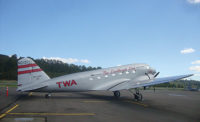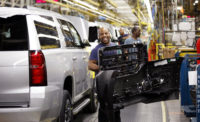On July 1, 1930, 200 metal trimmers and polishers at GM’s Fisher Body No.1 (Fisher One) in Flint, MI, laid down their tools and stormed off the job, hollering for others to follow. They were fed up with speedups and piecework payments that plant management imposed to reduce production costs. Some 2,000 other disgruntled workers joined in for two days of disruptive marches and demonstrations through downtown Flint and at Fisher One, where they blocked access to the plant. Parading and chanting with them were members of the Automotive Industrial Workers Association, a Detroit-based communist front that helped organize and lead the strike.
Sixty-five miles north of Detroit, Flint was the bastion of the GM empire—“a gritty monument to the transfiguring power of the industrial revolution,” declared historian David M. Kennedy. The first Buicks were built there in 1904, and the company now employed 47,000 workers in 13 plants in the city of 156,000 residents. Eighty percent of Flint families relied on GM for their livelihoods.
“We won’t have a bunch of Bolsheviks running this town,” warned police chief Caesar Scavarda. The mayor banned picketing, and the chief mobilized 150 local and state police and county sheriff deputies for a showdown. The governor dispatched National Guard troops to back them up.
GM began hiring replacements and reopened Fisher One a week after the walkout, prompting about two-thirds of the 7,000 employees to return to work. State police, riding two abreast and swinging riot clubs, scattered 2,500 jeering strikers and supporters pressed together on the sidewalk across from the plant. Cops on foot walloped resistors with blackjacks and spent the rest of the day arresting “radicals from Detroit” or running them out of town.
Defeated strikers trudged back to Fisher One, greeted by unrelenting speedups to build bodies for 181,700 Buicks assembled that year. By all accounts, the first big automobile industry strike of the 1930s failed. In fact, it was the opening salvo in a labor war centered in the economic, political, societal and cultural upheaval of the Great Depression. Labor problems continued to plague Fisher One over the next seven years, culminating in a worker takeover that burst open the floodgates to unionization of America’s mass-production industries and permanently transformed the balance of power between management and employees.
RECOVERY ACT TRIGGERS UNION GROWTH
By the end of 1932, the depression gripped the economy in a choke hold. GM’s output tumbled to 500,000 vehicles from the 1929 high of 1.9 million, leading to a 50 percent cutback in the company’s workforce. Knowing they were easily replaceable, restive workers avoided any involvement or even interest in a union. Loss of a job could mean swift descent into the ranks of 34 million Americans without incomes.
Franklin D. Roosevelt cruised to the presidency in 1932 on his New Deal plan to restructure the American economy and rekindle hope among the nation’s idled masses. Four months after his inauguration, he signed the National Industrial Recovery Act (NIRA), a farrago of 756 industry codes regulating prices, production, minimum wages, and maximum hours for thousands of businesses of all types and sizes. Buried within 13,000 pages of abstruse legalese lay Section 7(a), proclaiming worker rights to “organize and bargain collectively through representatives of their own choosing…free from interference, restraints, coercion or discrimination.” These historic phrases launched an era of dynamic union growth under the aegis of the federal government.
An organization drive by the American Federation of Labor (AFL), an amalgam of mostly skilled trade unions, claimed to enlist 100,000 unskilled and semiskilled autoworkers. Whatever the number, it was enough to charter 183 locals placed near OEM and supplier plants. Rebellious young militants in the locals chafed under timid AFL policies and overbearing controls and charged ahead with protest demonstrations and wildcat strikes, often involving pitched battles with police and strikebreakers. Many locals bailed out to form independent unions, while mass resignations by disenchanted members shut down others.
During the summer of 1935, the AFL reluctantly combined the remaining locals and their 23,000 members into the United Auto Workers of America (UAW) and appointed the organization’s president and board members. This was unacceptable, and a year later the fledgling union elected its own slate of officers, and soon after affiliated with the Committee of Industrial Organizations (CIO). The CIO was a coalition of labor organizations cobbled together by John L. Lewis, president of the United Mine Workers, an AFL member union.
Lewis had embarked on a crusade to unite the country’s 35 million mass production workers under the CIO banner. A 230-pound, roughhouse former coal miner, Lewis had a glowering scowl accented by beetle brows that could nest a couple hummingbirds. He would become America’s most prominent and pugnacious labor leader. The UAW embraced him as its national spokesperson, lead negotiator and man in Washington. Freed from AFL constraints, the UAW now had the backing of a well-funded union with experienced, aggressive leadership. The AFL purged the CIO, which promptly retitled itself the Congress of Industrial Organizations.
TAKING ON THE COLOSSUS
Other powerful forces coalesced around the UAW. “If I were a factory worker, I would join a union,” President Roosevelt proclaimed at a 1936 campaign rally where he maligned big business as a “degenerate system of financial capitalism that caused the depression.” He won 46 of 48 states, helped by almost $600,000 in CIO donations. The electoral tsunami swept progressive governors into office, among them Frank Murphy of Michigan, former mayor of Detroit and future U.S. Supreme Court justice, who said, “I am in the heart and soul of labor.” The Supreme Court nullified NIRA, but Congress countered with the Wagner Act empowering the National Labor Relations Board to mediate labor disputes, oversee collective bargaining and union elections, and punish labor law violators.
The auto industry did its part, ringing up 3.7 million sales in 1936, highest since 1929, while restoring auto plant employment close to predepression levels. Despite these favorable developments, the UAW Flint local languished at a skimpy 122 members, many of them company stool pigeons. Intimidation and reprisals made membership too risky. A clandestine campaign pulled in 4,000 new members, barely 10 percent of the city’s automotive workforce.
To earn worker trust and the right to speak for them, the upstart union had to confront and defeat GM, the industrial colossus that controlled almost 45 percent of domestic auto sales and employed 240,000 workers in 69 plants. In 1936, GM’s net profits approached $284 million, and its $1.4 billion in gross income exceeded the annual revenues of any American state.
Angry workers forced the issue on Dec. 30, 1936, when they stormed into the UAW hall across the road from Fisher One during their swing shift meal break. They were enraged over the company’s plan to eliminate jobs by removing dies from the plant for installation in a less volatile environment. “What do you want to do?” 27-year-old Robert Travis, UAW Flint leader, challenged them. “Shut it down, shut the goddamn plant down!” they bellowed.
Before the shift ended at 11 p.m., they had overpowered and forced out foremen and guards and barricaded entrances with piles of unfinished Buick bodies. “She’s ours!” strikers cried from third-floor windows. The world’s largest auto body plant went silent, and the most far-reaching labor action of the century was underway.
GM denounced the occupation as illegal, which it was. Employees had seized private property, held it by force and were prepared to resist by violence any efforts to repossess it. “We will not negotiate with a union while its agents forcibly hold possession of our property,” said GM President Alfred P. Sloan. President Roosevelt begged to differ: “What laws have they broken?” he innocently inquired. “The law of trespass? Why can’t these fellows at General Motors meet with a committee of workers?”
A couple days after the takeover, the company secured an injunction ordering strikers to evacuate the plant. The UAW held a press conference and gleefully revealed that the 83-year-old judge who issued the decree owned $219,000 worth of GM stock. The injunction died an obscure death. Gov. Murphy quickly and discreetly unloaded his $104,000 in GM shares.
Seven-hundred strikers (their numbers ranged from well over a thousand to fewer than 200 over the next six weeks) settled in for a long siege. They organized committees responsible for plant security, facility cleanups, worker health and safety, postal services, and picketing duties. Liquor and guns were banned, and everyone had to work six hours a day. Sleeping arrangements were plentiful on makeshift beds stuffed with wadding used in car seats.
A recreation area had plenty of room for ping pong, card games, lectures on labor union history and procedures, and boxing and wrestling matches. A well-stocked library offered books, magazines and newspapers. Local bands and musicians among the strikers, including a “hillbilly orchestra,” serenaded sit-downers, most with origins in Midwest farms and northern Michigan logging camps.
Sensitive to public opinion and concerned over vandalism of million-dollar machines, GM left the heat and lights on, allowed food and meal deliveries organized by the union’s Women’s Auxiliary, and maintained regular trash collections. Union officials and strike leaders met daily in the plant or at UAW headquarters. Politicians and journalists sympathetic to the union cause were welcomed in for tours and interviews. Sit-downers could leave for a few days to visit their families.
BATTLE OF THE RUNNING BULLS
Two miles away, a sit-down strike at the much smaller Fisher Two Chevrolet body plant erupted in violence on Jan. 11, 1937, when a flying squad of picketers rammed through the gate that GM guards locked to prevent dinner deliveries. Earlier, plant management turned off the heat on a blustery 16 F day. A hundred or so strikers were shivering inside when a fleet of police cars roared up, sirens shrieking. Officers in gas masks, riot shields and helmets leaped out and shot hissing canisters of tear gas into the plant and lobbed them at picketers. Sit-downers drenched their assailants with icy torrents from high-pressure fire hoses and fusillades of two-pound steel door hinges, milk bottles and bricks. Picketers clobbered cops with blackjacks that strikers had fashioned from rubber hoses and leather-bound lead.
Police retreated to regroup while a mob gathered to help repel a second attack fought in swirling mists of tear gas. The melee ended when outnumbered cops backed off, leaving behind destroyed scout cars. Twelve officers were injured, and 14 picketers were treated for buckshot wounds from police riot guns. The conflict passed into UAW lore as the Battle of the Running Bulls—the bulls, 1930s slang for police, ran away.
Gov. Murphy, just 11 days in office, sided with the strikers, but was appalled by the violence and sent in 1,200 National Guardsmen to maintain order and billet in an abandoned school until the strike ended. “The people of Flint will not be terrorized,” he said. “The state of Michigan will reign supreme.” He also emphasized that the Guard was there as a neutral peacekeeping force, not to evict sitdowners from the two plants. “I will not go down in history as Bloody Murphy,” he vowed.
By late January, the strike reached an impasse. Bored and restless sit-downers, concerned that they had signed up for a lost cause, were leaving to rejoin their families. Thousands of unemployed Flint autoworkers clamored loudly and often to return to work and restore their incomes. The Flint economy tanked. Things were worse at GM. Fifty plants in 35 communities and 14 states were either on strike or shut down, idling 135,000 workers. Normal production runs of 1,500 to 2,000 vehicles a day trickled down to 120 a week.
Both sides went for the knockout blow. GM filed for a second injunction to evacuate the plants, careful to choose a judge unencumbered by GM stock holdings. The UAW counterpunched with a secretive plot for a coup at Chevy Four, an impregnable fortress where 14,000 workers turned out a million engines annually for all Chevrolets, the company sales champ. The union planted a phony story with company spies about a planned strike set for Feb. 1 at the Chevrolet Nine bearing plant. GM swallowed the bait and assigned extra guards, removing them from their normal shifts at other facilities, including Chevy Four.
On the allotted day, the beefed-up plant protection detail attacked Chevrolet Nine workers who refused to leave at the end of the first shift. Workers from other plants raced to the scene and battled police and guards outside. The Women’s Brigade, the militant branch of the Women’s Auxiliary, shattered plant windows with crowbars and stove pokers to allow tear gas fumes to escape. The fracas left 17 injured but allowed time for 2,000 strikers at Chevy Four to force out the understaffed guard unit and initiate the real sit-down. Gov. Murphy felt betrayed and rushed in 2,200 more National Guard troops to augment those in place.
Thirty-four-hundred guardsmen, bayonets fixed to automatic rifles slung from their greatcoats, formed an 80-acre cordon around Chevy Four and Fisher Two, blocking all access to the plants—a “ring of steel,” as one newspaper headlined it. Machine guns capable of firing 500 rounds a minute and howitzers loaded with smoke cartridges were mounted on surrounding hills and streets, pointing directly at the plants. On Feb. 2, the judge issued an injunction ordering evacuation of the three striking facilities by the following afternoon.
UAW “shock troops” from Detroit, Toledo, Cleveland, and other GM strongholds swarmed into the city, weapons in hand, and joined 10,000 others surrounding Fisher One, all prepared to combat any attempts to enforce the evacuation ruling. Inside, sitdowners, some with handguns and rifles, had pledged a “fight to the death” rather than be forced out. Five hundred Women’s Brigade members wearing red berets and armbands marched through Flint on their way to join the impending battle. The entire Flint police force was on call, and hundreds of state police and sheriff deputies stood by with GM plant protection personnel and a thousand vigilantes deputized by Flint city officials.
The slightest provocation could have ignited industrial warfare, catastrophic loss of lives, and intervention of federal troops. Losing $2 million a day in sales and sitting on a powder keg with a lit fuse, GM announced it was ready to negotiate. Tensions eased but no one backed off.
UNION FLOODGATES BURST OPEN
Negotiations took place in Detroit in the office and jury room of Judge George Murphy, the governor’s brother. GM Executive Vice President William Knudsen, who had no serious problem with collective bargaining, represented the corporation, joined by the company’s anti-union finance and legal chiefs. John L. Lewis, all shrewd bluff and bombast, argued the union case, accompanied by UAW Vice President Wyndham Mortimer, the organization’s leading communist. The UAW had one overriding goal: achieve recognition as sole bargaining agent for all GM production facilities. GM refused to consider the demand, or any other issues, until sit-downers vacated the plants they were “holding for ransom.”
Gov. Murphy arbitrated tense, unyielding sessions stretching deep into morning hours, while maintaining close contact with the White House. At one point, the president called Knudsen who had scheduled an announcement that negotiations were deadlocked and GM was withdrawing. Labor Secretary Frances Perkins placed an emergency call to Lewis, who acceded to limiting union representation to 17 GM plants on strike around the country. The talks continued.
On Feb. 11 at 2:36 a.m. on the 44th day of the strike, an exhausted governor announced a six-month agreement in which sit-downers would leave the occupied plants on condition that GM refrain from bargaining with any other labor union during this period. In effect, but without acknowledging it, GM had conceded exclusive bargaining rights to the UAW for its industrial operations.
Perhaps fittingly, the top two signatures on the watershed pact were William Knudsen, for the exemplar of industrial capitalism, and Wyndham Mortimer, the hardcore union communist. John L. Lewis, the supreme pragmatist, signed the one-page, eight-paragraph document from his sick bed in the Statler Hotel in downtown Detroit, brought down by chronically scarred lungs carried over from his days in the coal mines. A few weeks later, UAW members approved the contract, and welcome blasts from plant whistles beckoned GM employees back to work.
The UAW went on a tear, signing deals with independent carmakers Studebaker, Hudson and Packard, and with major suppliers. Chrysler came aboard April 6 with an agreement covering workers in its Detroit facilities. Four turbulent years passed before Henry Ford caved in and gave the UAW sole bargaining power for his plants.
Carnegie-Illinois, the world’s largest steelmaker and subsidiary of U.S. Steel, took a lesson from the GM ordeal and approved a contract with the CIO Steel Worker’s Organizing Committee. Other steel companies fell in line. By the fall of 1937, the CIO boasted 3.4 million members, surpassing the AFL. Among them were 400,000 card-carrying UAW members. The floodgates of industrial unionization had sprung open, thanks to bolts loosened by strikers at Fisher One during their July 1930 walkout.
















